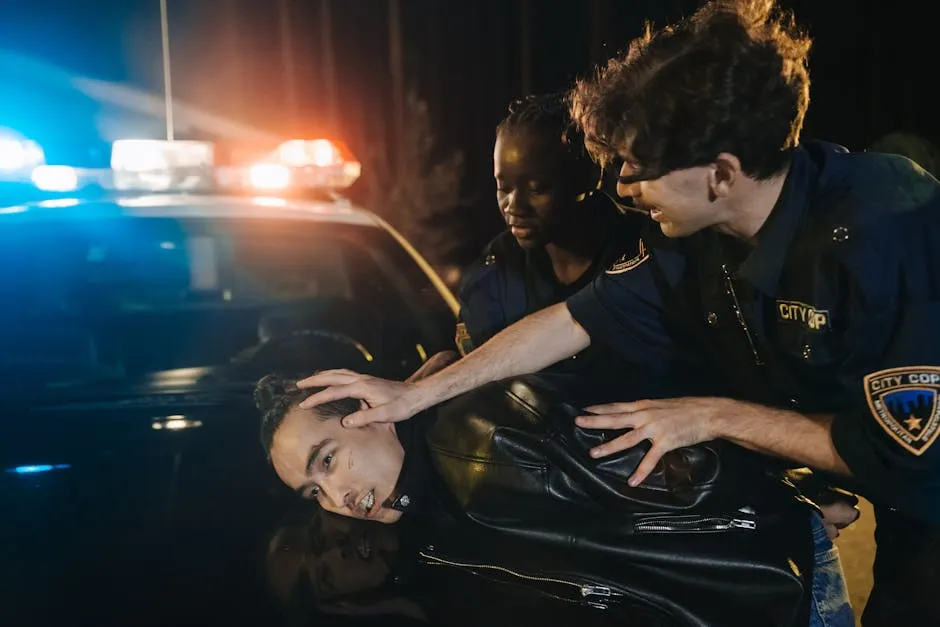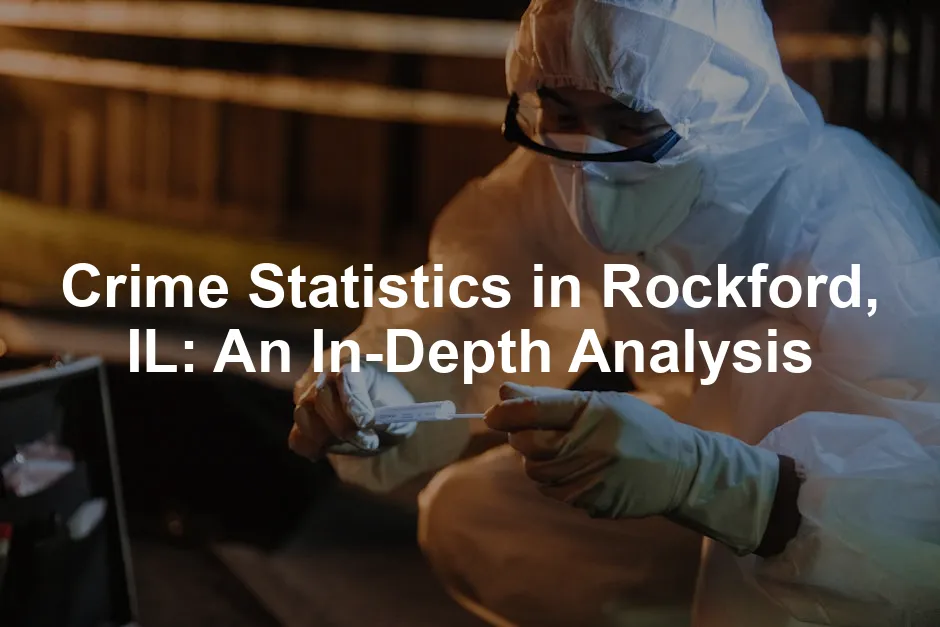Introduction
Welcome to Rockford, Illinois! Known for its rich history and vibrant community, Rockford also has a reputation that raises eyebrows—especially regarding crime rates. With crime statistics that often land it on the infamous list of America’s most dangerous cities, understanding these numbers is essential for current residents, prospective movers, and policymakers alike.
Why should you care about crime statistics? Well, for residents, these figures can impact your daily life. For potential movers, they might influence your decision on whether to pack your bags or stick around. Policymakers rely on this data to make informed decisions about resource allocation, community programs, and law enforcement strategies. It’s about safety, clarity, and taking action where needed.
If you’re looking to understand crime and community better, consider diving into Crime and Community: A Comprehensive Guide to Urban Safety. This book provides insights into urban safety and community engagement, perfect for those wanting to make informed decisions in an urban environment.
In this article, we’ll take a closer look at the crime landscape in Rockford. We’ll cover violent and property crime statistics, recent trends, and how Rockford compares to national averages. Plus, we’ll explore how residents perceive safety in their neighborhoods. So, grab your magnifying glass; it’s time to investigate the crime statistics of Rockford, IL!

Understanding Crime Statistics
Crime statistics are numerical representations of the frequency and types of crimes occurring within a specific area. They serve several purposes, including measuring crime trends, assessing community safety, and guiding law enforcement strategies. Think of them as the scorecard for a city’s safety.
How do we gather this data? It’s primarily collected through the FBI’s Uniform Crime Reporting (UCR) Program, which compiles data from local law enforcement agencies across the country. Rockford’s police department contributes significant data, ensuring the information reflects the reality on the ground. This process involves not only recording reported incidents but also categorizing them into specific types of crime—violence, theft, and property damage, to name a few.
Every year, the FBI releases these statistics, providing crucial insights into crime trends. For Rockford, understanding this data is key to addressing safety concerns and improving community well-being. It’s like having a map in a maze; without it, you might just stumble around blindly!
For those who want to dive deeper into the psychology behind criminal behavior, The Psychology of Criminal Conduct is a great read. It delves into the motivations behind crime, helping you understand the broader context of urban safety.
Ready to unravel the mystery of Rockford’s crime statistics? Stay tuned as we dive deeper into the specifics of violent and property crime rates in the city.

Importance of Crime Statistics in Urban Planning
Crime statistics play a pivotal role in shaping urban planning. They guide city officials in making informed decisions. Understanding crime patterns helps allocate resources efficiently. For instance, if a neighborhood shows high burglary rates, local law enforcement can increase patrols and visibility.
Moreover, these statistics inform community safety initiatives. Cities can implement programs aimed at violence prevention, youth engagement, and neighborhood watch schemes. When residents feel safe, it fosters community pride and encourages investment.
Additionally, urban planners use crime data to design safer environments. Well-lit streets, open public spaces, and community centers can deter criminal activities. By understanding where crime occurs, planners can create spaces that promote safety and well-being. Ultimately, crime statistics are not just numbers; they are essential tools for building safer, more vibrant communities.
For those invested in community safety, consider equipping your home with a Home Security Alarm System. It’s an essential layer of protection that can help deter crime and give you peace of mind.

Overview of Rockford, IL Crime Statistics
Rockford, Illinois, faces significant challenges with crime. The overall crime rate stands at approximately 5,964 incidents per 100,000 residents. To put this into perspective, it’s about 74.9% higher than the national average of 2,324 per 100,000 residents. Violent crimes account for 2,098 incidents, translating to a staggering 286.7% higher than the national median. This alarming data reveals the pressing need for community safety measures and urban development.
The implications of these figures are severe. They signal to residents and potential movers that Rockford is grappling with safety concerns. Understanding these statistics is crucial for policymakers, law enforcement, and community leaders to devise targeted strategies.
Breakdown of Violent and Property Crimes
Violent Crimes
Rockford’s violent crime rate is particularly concerning, with a total of 2,098 incidents reported. This breaks down as follows:
- Homicide: 16 incidents (rate: 10.9)
- Rape: 128 incidents (rate: 87.2)
- Robbery: 202 incidents (rate: 137.7)
- Assault: 1,752 incidents (rate: 1,194.2)
Property Crimes
Property crimes in Rockford also present a worrying trend, with a total of 3,866 incidents reported. Here’s the breakdown:
- Burglary: 626 incidents (rate: 426.7)
- Theft: 2,470 incidents (rate: 1,684.8)
- Motor Vehicle Theft: 770 incidents (rate: 524.8)
With property crime rates significantly exceeding national averages, residents must remain vigilant. The risk of becoming a victim of property crime is a stark reality for many living in Rockford.
Understanding these crime statistics is vital for residents and law enforcement alike. They help shape responses to crime and guide efforts for community safety. By addressing these issues head-on, Rockford can work towards a safer and more secure future for all its residents.

To further educate yourself on the complexities of crime and its societal impacts, consider reading The New Jim Crow: Mass Incarceration in the Age of Colorblindness. This book explores the intersection of race and the criminal justice system, providing a broader perspective on crime in America.
To gain a deeper understanding of crime statistics, you can explore the fremont crime statistics, which can provide insights into broader trends.

Recent Trends in Crime Rates
Year-over-Year Analysis
Rockford, IL, has seen a rollercoaster ride of crime statistics in recent years. The overall crime rate now sits at a staggering 5,964 incidents per 100,000 residents, a figure that raises eyebrows and a few heartbeats. Recent data reveals a slight 3.1% uptick in total crime rates. But hold onto your hats, because not all the news is grim!
Violent crimes tell a different story. They have decreased by 5.1%, which is a bright spot in a rather cloudy statistic report. Specifically, the number of homicides in 2023 rose to 20, up from 15 in 2022. This slight increase might feel disheartening, especially amidst a general decline in violent crime. However, the overall trend is promising, with aggravated assaults dropping significantly—down nearly 20% compared to previous years.
On the flip side, property crimes are showing a troubling trend. These offenses have increased by 8.2%, marking the third consecutive year of rising property crime rates. With a total of 3,866 property crimes reported, Rockford residents must stay vigilant. The increasing number of burglaries and thefts indicates a pressing need for community engagement and law enforcement efforts to combat this wave of property crime.

To enhance personal safety and deter potential threats, consider investing in a Outdoor Security Camera System. It’s a proactive measure that can help monitor your property and provide peace of mind.
Seasonal Trends and Patterns
Crime in Rockford doesn’t just happen randomly; it follows a pattern that can be as predictable as your grandma’s holiday fruitcake. Seasonal trends show that crime often spikes during warmer months. Why? People are out and about, and unfortunately, some of them get into mischief.
Community events like summer fairs and festivals can bring joy, but they can also attract unsavory characters. Law enforcement initiatives during these events aim to enhance safety; however, it’s essential for residents to remain aware and report suspicious activity.
Additionally, the holidays can see a rise in property crimes, as thieves look to take advantage of distracted shoppers and festive decorations. Community vigilance during shopping seasons can make a world of difference. Ensuring public safety requires a collaborative effort between residents, law enforcement, and local organizations.
Neighborhood-Specific Crime Data
Safest Neighborhoods in Rockford
While Rockford’s overall crime statistics may sound like a horror movie, don’t pack your bags just yet! There are neighborhoods where the crime rates are lower than a limbo stick at a party. Let’s shine a light on these safer havens.
- Prairie Ridge: This neighborhood boasts a reputation for safety, with well-lit streets and active community watch programs. Residents feel secure enough to take evening strolls without constantly checking over their shoulders.
- Tullocks Woods Neighborhood Group: Known for its friendly atmosphere, Tullocks Woods has a low crime rate. The strong sense of community and active engagement in neighborhood events keeps crime at bay.
- Springlake Estates / Spring Lake: Families flock to this area for its lush parks and excellent schools. A proactive neighborhood association ensures that safety is a top priority.
- Edgebrook / Hawthorn Hills: This area is not just safe; it’s a picturesque community. Families here enjoy a low crime rate thanks to regular neighborhood meetings and community improvement initiatives.
- Quail Run / Reid Farm Group: With beautiful homes and a tight-knit community, Quail Run residents take pride in their neighborhood. Crime is minimal, thanks to the collective efforts of residents and law enforcement.
Factors contributing to safety in these areas include active neighborhood associations, community events, and effective law enforcement presence. Residents engage in regular communication about safety concerns and work together to foster a secure environment.
In conclusion, while Rockford faces significant crime challenges, it also boasts neighborhoods where safety thrives. Engaging in community efforts and staying informed can make all the difference. Residents should feel empowered to create a safer Rockford; after all, safety isn’t just a statistic—it’s a community effort!

Most Dangerous Areas
When it comes to Rockford, some neighborhoods are tougher than others. The areas with the highest crime rates often include parts of downtown, East Rockford, and the area surrounding the Rock River. Residents in these neighborhoods face more challenges than those in others.
Why is this the case? Socioeconomic conditions play a significant role. High unemployment rates and lower educational attainment contribute to crime. When jobs are scarce, some individuals may resort to illegal activities to make ends meet.
Another factor is the police presence. In areas with high crime rates, police visibility is crucial. Unfortunately, budget constraints sometimes limit law enforcement resources. This can lead to a cycle where crime breeds more crime.
Community programs can help break this cycle. Initiatives focusing on youth engagement and job training create opportunities. They provide alternatives to criminal activities and foster a sense of belonging. When residents feel connected, they are more likely to take pride in their neighborhoods and work together for safety.

Visual Representation of Crime Data
To truly grasp the crime landscape in Rockford, visual representations are invaluable. Crime maps or charts can help illustrate the distribution of crime across neighborhoods. These visuals allow residents to identify areas that may require extra caution.
Heat maps, for instance, can pinpoint where incidents are concentrated. They show the intensity of crime in various regions, making it easier for residents to understand which neighborhoods are safer.
Charts comparing different types of crime can also provide clarity. They can highlight trends over time, allowing residents to see if crime is increasing or decreasing. For instance, a chart showing the rise in property crimes during certain seasons can encourage community vigilance.
By utilizing these tools, residents can make informed decisions about their safety and well-being. After all, knowledge is power, especially when it comes to protecting your home and loved ones.

Comparison with National Averages and Nearby Cities
Rockford vs. National Crime Averages
When we stack Rockford’s crime rates against national averages, the numbers tell a startling story. Below is a table summarizing the key comparisons:
| Statistic | Rockford (per 100k people) | National Average (per 100k people) |
|---|---|---|
| Total Crime | 5,964 | 2,324 |
| Violent Crime | 2,098 | 370 |
| Property Crime | 3,866 | 1,954 |
| Murder | 16 | 6.3 |
| Rape | 128 | 40.0 |
| Robbery | 202 | 66.1 |
| Assault | 1,752 | 268.2 |
| Burglary | 626 | 208.5 |
| Theft | 2,470 | 1,192.7 |
| Vehicle Theft | 770 | 281.6 |
These numbers reveal a stark reality. Rockford’s total crime rate is approximately 74.9% higher than the national average. Violent crime is particularly alarming, with a rate that is 286.7% higher than the national median.

For those interested in the broader implications of crime, The Crime Book: Big Ideas Simply Explained is a fantastic resource. It breaks down complex concepts in crime and justice, making them accessible for everyone.
Comparison with Neighboring Cities
How does Rockford stack up against nearby cities like Loves Park and Machesney Park? The contrast is eye-opening.
In Loves Park, the violent crime rate is significantly lower, with only 318.1 incidents per 100,000 residents. Machesney Park is even safer, boasting a mere 247.9 incidents. Rockford’s property crime rate is similarly high.
This comparison highlights a troubling trend. While Rockford faces significant crime challenges, its neighboring cities enjoy much lower rates. For instance, Loves Park has a property crime rate of 1,719.3, while Machesney Park’s is 1,850.0.
Residents should take these comparisons to heart. Understanding the crime landscape relative to nearby areas can help inform safety decisions. Community members should advocate for stronger law enforcement presence and support local initiatives aimed at reducing crime. By banding together, they can work toward a safer Rockford.

Community Response and Safety Perception
Community Sentiment on Crime and Safety
Rockford’s residents have a lot to say about safety. Community surveys reveal a stark contrast in perceptions. A poll conducted by AreaVibes found that a mere 11% of residents feel safe walking alone at night. That’s right—89% feel uneasy about their surroundings. It’s like living in a thriller movie, but without the popcorn!
These sentiments significantly influence daily life in Rockford. When people don’t feel safe, their routines change. Morning jogs become evening couch marathons, and spontaneous outings turn into planned events with safety in mind. This anxiety can affect mental health, community engagement, and even local businesses.
The fear of crime can also lead to a divide among neighbors. When residents feel vulnerable, they may retreat into their homes, missing opportunities to build community connections. After all, who wants to mingle when there’s a chance of becoming the next crime statistic? This isolation can create a cycle of fear that further diminishes the neighborhood spirit.

Law Enforcement and Community Programs
Local law enforcement is stepping up to combat crime. The Rockford Police Department has implemented several initiatives aimed at enhancing community safety and trust. Their focus? Building relationships with residents and addressing concerns proactively.
One significant effort is the Community Policing Program. Officers engage with the community through events and activities, fostering a sense of security. This initiative allows residents to meet officers on friendly terms—like having a friendly chat with your neighbor rather than a stern lecture about safety.
In addition to law enforcement, various community programs are making waves. The Rockford Promise initiative covers full college tuition for local high school graduates attending Northern Illinois University. By investing in education, the program aims to provide young people with opportunities, steering them away from criminal activities.
Another impactful program is the Workforce Development Initiative. This initiative pairs young adults with community leaders, teaching them valuable skills in construction and trades. By creating job opportunities, Rockford hopes to reduce crime rates and empower its youth.
These combined efforts indicate a community on the move. Residents are not just waiting for change—they’re actively participating in creating a safer environment. Through collaboration, Rockford can transform its narrative from one of fear to one of hope and resilience.

Conclusion
In summary, Rockford, IL, faces significant challenges regarding crime rates. The statistics reveal a pressing need for continued community engagement and strong law enforcement presence. With a total crime rate significantly higher than the national average, residents must be vigilant.
However, there’s a silver lining. Despite high crime rates, initiatives like community policing and educational programs show promise. They reflect a city that is willing to face its challenges head-on. For current residents and potential movers, these efforts are crucial. They indicate that change is possible when the community rallies together.
Understanding the crime landscape is essential for making informed decisions about living in Rockford. As we look to the future, it’s vital to prioritize community safety and collaboration. A united front can make all the difference in building a safer Rockford for everyone.

For emergency preparedness, consider assembling an Emergency Preparedness Kit. It’s a must-have for any household, ensuring you’re ready for anything life throws your way!
FAQs
What is the overall crime rate in Rockford, IL?
The overall crime rate in Rockford is approximately 5,964 incidents per 100,000 residents. This figure is significantly higher than the national average of 2,324 per 100,000 residents.
How does Rockford’s crime rate compare to other cities in Illinois?
Rockford’s crime rate is about 74.9% higher than the Illinois average of 4,065 per 100,000 residents, making it one of the highest crime rate cities in the state.
What are the safest neighborhoods in Rockford?
Some of the safest neighborhoods in Rockford include:Prairie RidgeTullocks Woods Neighborhood GroupSpringlake Estates / Spring LakeEdgebrook / Hawthorn HillsQuail Run / Reid Farm Group
What should residents do to stay safe in Rockford?
Residents should:Stay aware of their surroundings.Avoid isolated areas, especially at night.Participate in neighborhood watch programs.Report suspicious activity to local law enforcement.
How can I access more detailed crime statistics for Rockford?
For more detailed crime statistics, visit the Rockford Police Department’s website or check community resources like NeighborhoodScout and AreaVibes, which provide comprehensive crime data.
Please let us know what you think about our content by leaving a comment down below!
Thank you for reading till here 🙂
All images from Pexels




